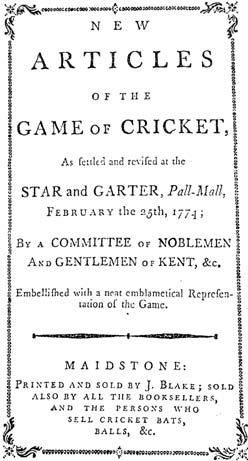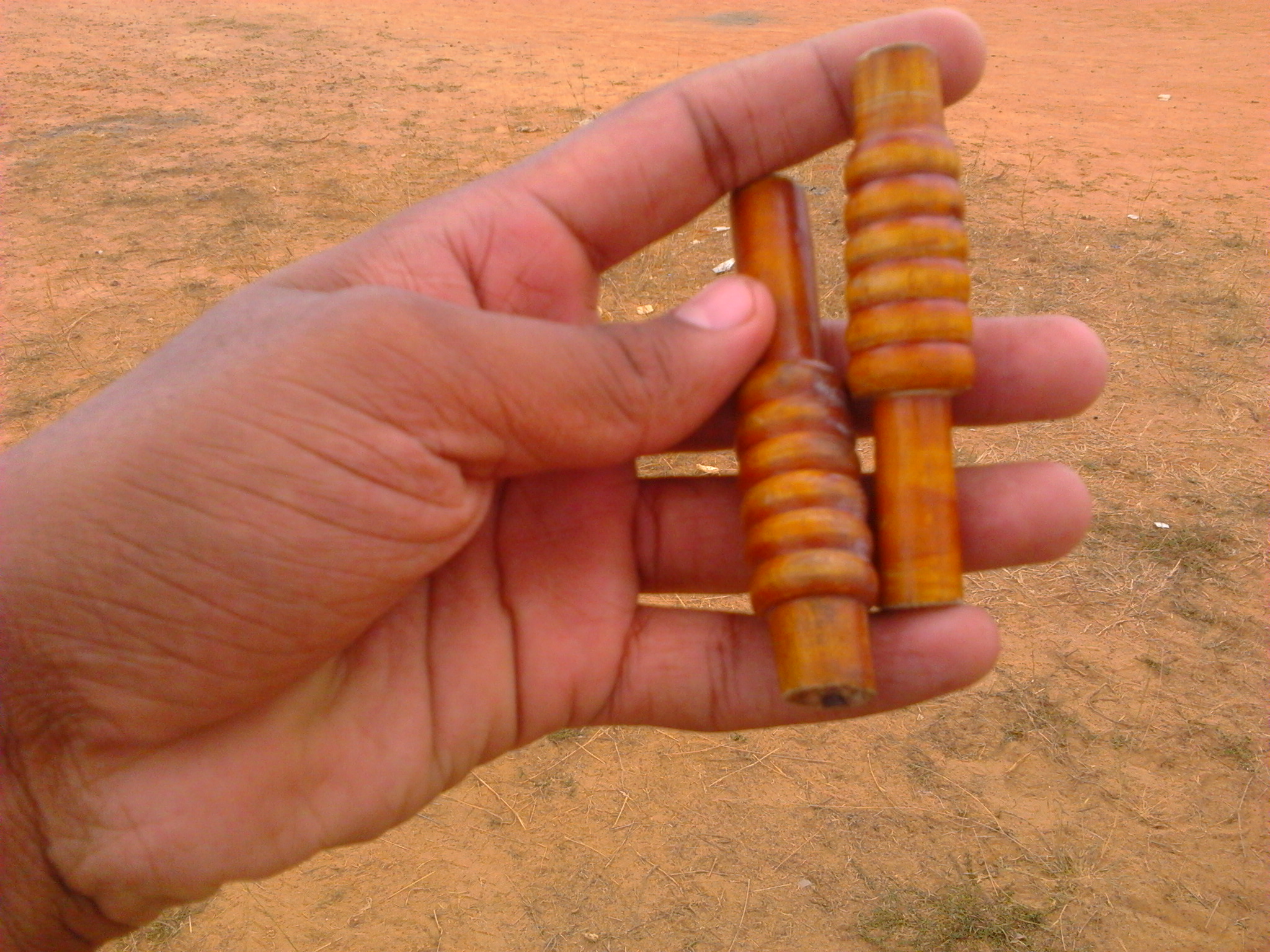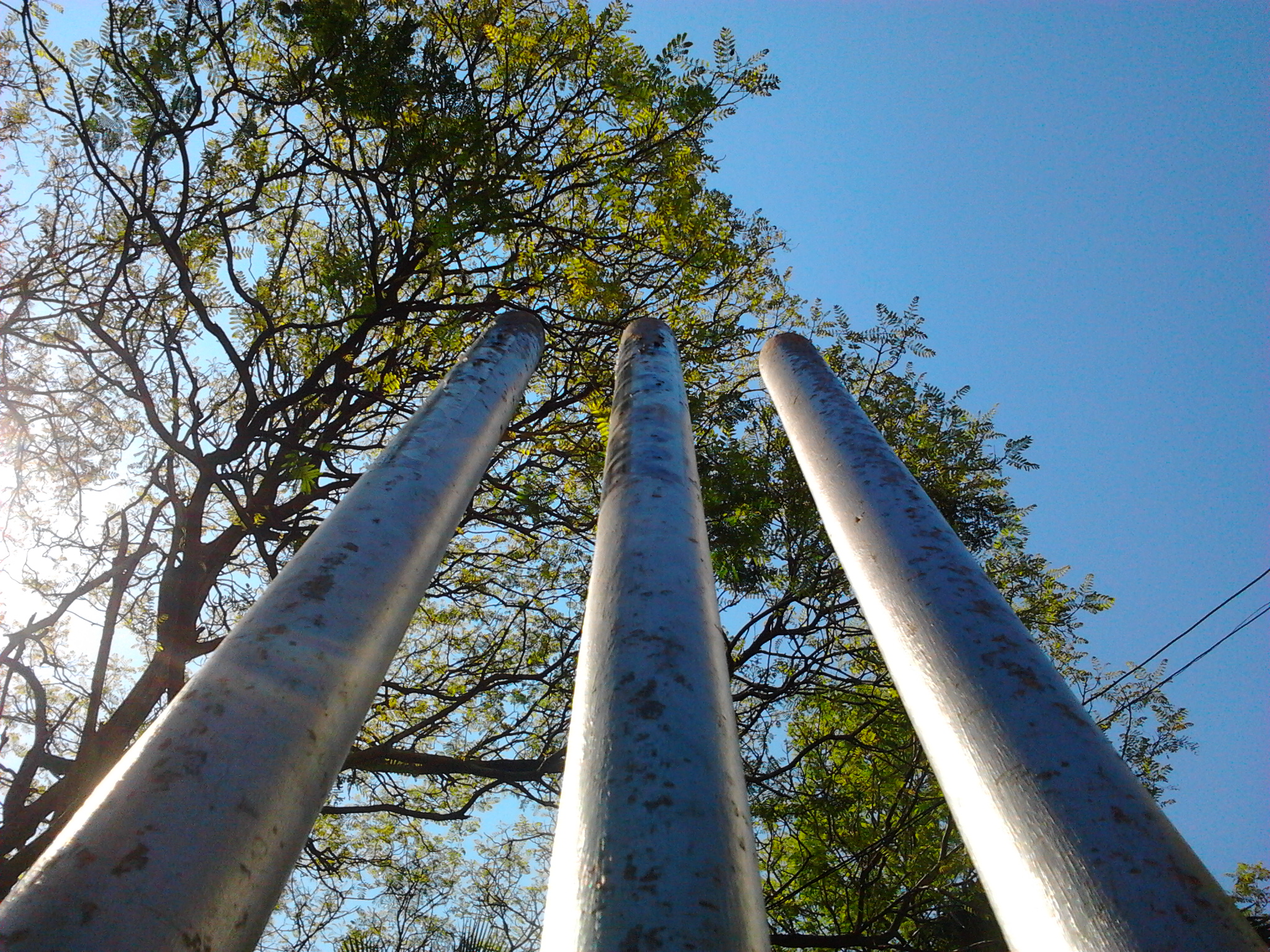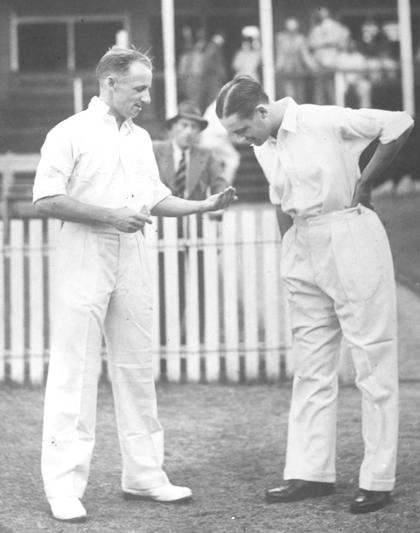|
Laws Of Cricket
The ''Laws of Cricket'' is a code which specifies the rules of the game of cricket worldwide. The earliest known code was drafted in 1744 and, since 1788, it has been owned and maintained by its custodian, the Marylebone Cricket Club (MCC) in London. There are currently 42 Laws (always written with a capital "L") which outline all aspects of how the game is to be played. MCC has re-coded the Laws six times, the seventh and latest code being released in October 2017. The 2nd edition of the 2017 Code came into force on 1 April 2019. The first six codes prior to 2017 were all subject to interim revisions and so exist in more than one version. MCC is a private club which was formerly cricket's official governing body, a role now fulfilled by the International Cricket Council (ICC). MCC retains copyright in the Laws and only the MCC may change the Laws, although usually this is only done after close consultation with the ICC and other interested parties such as the Association of Crick ... [...More Info...] [...Related Items...] OR: [Wikipedia] [Google] [Baidu] |
Cricket
Cricket is a bat-and-ball game played between two teams of eleven players on a field at the centre of which is a pitch with a wicket at each end, each comprising two bails balanced on three stumps. The batting side scores runs by striking the ball bowled at one of the wickets with the bat and then running between the wickets, while the bowling and fielding side tries to prevent this (by preventing the ball from leaving the field, and getting the ball to either wicket) and dismiss each batter (so they are "out"). Means of dismissal include being bowled, when the ball hits the stumps and dislodges the bails, and by the fielding side either catching the ball after it is hit by the bat, but before it hits the ground, or hitting a wicket with the ball before a batter can cross the crease in front of the wicket. When ten batters have been dismissed, the innings ends and the teams swap roles. The game is adjudicated by two umpires, aided by a third umpire and matc ... [...More Info...] [...Related Items...] OR: [Wikipedia] [Google] [Baidu] |
Cricket Bat
A cricket bat is a specialised piece of equipment used by batters in the sport of cricket to hit the ball, typically consisting of a cane handle attached to a flat-fronted willow-wood blade. It may also be used by a batter who is making ground to avoid a run out, by holding the bat and touching the ground with it. The length of the bat may be no more than 38 inches (96.5 cm) and the width no more than 4.25 inches (10.8 cm). Its use is first mentioned in 1624. Since 1979, a law change has provided that cricket bats can only be made from wood. Construction The ''blade'' of a cricket bat is a wooden block that is generally flat on the striking face and with a ridge on the reverse (back) which concentrates wood in the middle where the ball is generally hit. The bat is traditionally made from willow wood, specifically from a variety of white willow called cricket bat willow ('' Salix alba'' var. ''caerulea''), treated with raw (unboiled) linseed oil, which has a prot ... [...More Info...] [...Related Items...] OR: [Wikipedia] [Google] [Baidu] |
Obstructing The Field
Obstructing the field is one of the ten methods of dismissing a batsman in the sport of cricket. Either batsman can be given out if he wilfully attempts to obstruct or distract the fielding side by word or action. It is Law 37 of the Laws of cricket, and is a rare way for a batsman to be dismissed; in the history of cricket, there has been only one instance in Test matches, six occasions in One Day International (ODI) games, and only one instance in Twenty20 International matches. There have also been seven instances in Test cricket, and two in ODIs, where a batsman has been dismissed handled the ball, a mode of dismissal now folded into obstructing the field. One modern pattern of obstruction in limited overs cricket occurs when a batsman thinks that he is going to be run out and blocks the ball with his bat, or changes his course while running between wickets to block the ball. The obstruction has to be deliberate. The only time a batsman has been dismissed obstructing ... [...More Info...] [...Related Items...] OR: [Wikipedia] [Google] [Baidu] |
Hit The Ball Twice
Hit the ball twice, or ''"double-hit"'', is a method of dismissal in the sport of cricket. Its occurrence in modern cricket is exceptionally rare. Definition Law 34.1 of the Laws of Cricket states: 34.1 Out Hit the ball twice 34.1.1 The striker is out Hit the ball twice if, while the ball is in play, it strikes any part of his/her person or is struck by his/her bat and, before the ball has been touched by a fielder, the striker wilfully strikes it again with his/her bat or person, other than a hand not holding the bat, except for the sole purpose of guarding his/her wicket. 34.1.2 For the purpose of this Law ‘struck’ or ‘strike’ shall include contact with the person of the striker. A player can hit the ball twice in order to prevent it from hitting his/her stumps but not with a hand that is not in contact with the bat and not if doing so prevents a catch being taken (in which case they would be out obstructing the field). The bowler does not get credit for the wicket. ... [...More Info...] [...Related Items...] OR: [Wikipedia] [Google] [Baidu] |
No Ball
In cricket, a no-ball is a type of illegal delivery to a batter (the other type being a wide). It is also a type of extra, being the run awarded to the batting team as a consequence of the illegal delivery. For most cricket games, especially amateur, the definition of all forms of no-ball is from the MCC ''Laws of Cricket.'' The delivery of a no-ball results in one run – two under some regulations – to be added to the batting team's overall score, and an additional ball must be bowled. In addition, the number of ways in which the batter can be given out is reduced to three. In shorter competition cricket, a batter receives a free hit on the ball after any kind of no-ball (see below); this means the batter can freely hit that one ball with no danger of being out in most ways. No-balls due to overstepping the crease are common, especially in short form cricket, and fast bowlers tend to bowl them more often than spin bowlers. It is also a no-ball when the bowler's back foot ... [...More Info...] [...Related Items...] OR: [Wikipedia] [Google] [Baidu] |
Delivery (cricket)
A delivery or ball in cricket is a single action of bowling a cricket ball toward the batsman. Once the ball has been delivered, batsmen may attempt to score runs, with the bowler and other fielders attempting to stop this by getting the batsmen out. When the ball becomes dead, the next delivery can begin. During play of the game, a member of the fielding team is designated as the bowler, and bowls deliveries toward the batsman. Six legal balls in a row constitutes an over, after which a different member of the fielding side takes over the role of bowler for the next over. The bowler delivers the ball from their end of the pitch toward the batsman standing at the opposite wicket at the other end of the pitch. Bowlers can be either left-handed or right-handed. This approach to their delivery, in addition to their decision of bowling around the wicket (from the sides of the wicket on the bowler's end) or over the wicket, is knowledge of which the umpire and the batsman a ... [...More Info...] [...Related Items...] OR: [Wikipedia] [Google] [Baidu] |
Over (cricket)
In cricket, an over consists of six legal deliveries bowled from one end of a cricket pitch to the player batting at the other end, almost always by a single bowler. A maiden over is an over in which no runs are scored that count against the bowler (so leg byes and byes may be scored as they are not counted against the bowler). A wicket maiden is a maiden over in which a wicket is also taken. Similarly, double and triple wicket maidens are when two and three wickets are taken in a maiden over. After six deliveries the umpire calls 'over'; the fielding team switches ends, and a different bowler is selected to bowl from the opposite end. The captain of the fielding team decides which bowler will bowl any given over, and no bowler may bowl two overs in succession. Overview Although this has not always been so, with overs of four and eight balls used in the past, currently an over must consist of six legal deliveries. If the bowler bowls a wide or a no-ball, that illegal deliv ... [...More Info...] [...Related Items...] OR: [Wikipedia] [Google] [Baidu] |
Bail (cricket)
In the sport of cricket, a bail is one of the two smaller sticks placed on top of the three stumps to form a wicket. The bails are used to determine when the wicket is ''broken'' or '' put down'', which in turn is one of the critical factors in determining whether a batsman is out bowled, stumped, run out or hit wicket. The wicket is considered to be broken if one or both of the bails fall from the stumps, or a stump is struck out of the ground, by: *the ball, *the striking batsman's bat, or any part of the striker's body or clothing (even if it falls off), or *a fielder with the hand or arm holding the ball. This means, for example, that if the ball hits the wicket directly from the bowler's delivery, the batsman is only out bowled if a bail falls off, so a ball can actually brush or rest against the stumps without the batsman being dismissed (as long as the bail remains in its groove). If a bail falls off the stumps for any other reason while the ball is still in play, a ... [...More Info...] [...Related Items...] OR: [Wikipedia] [Google] [Baidu] |
Stump (cricket)
In cricket, the stumps are the three vertical posts that support the bails and form the wicket. '' Stumping'' or ''being stumped'' is a method of dismissing a batsman. The umpire ''calling stumps'' means the play is over for the day. Part of the wicket The stumps are three vertical posts which support two bails. The stumps and bails are usually made of wood, most commonly ash Ash or ashes are the solid remnants of fires. Specifically, ''ash'' refers to all non-aqueous, non-gaseous residues that remain after something burns. In analytical chemistry, to analyse the mineral and metal content of chemical samples, ash ..., and together form a wicket at each end of the pitch. The overall width of each wicket is 9 inches (22.9 cm). Each stump is 28 inches (71.1 cm) tall with maximum and minimum diameters of 1 inches (3.81 cm) and 1 inches (3.49 cm). They have a spike at one end for inserting into the ground, and the other end has a U-shaped ... [...More Info...] [...Related Items...] OR: [Wikipedia] [Google] [Baidu] |
Toss (cricket)
In cricket, the toss is the flipping of a coin to determine which captain will have the right to choose whether their team will bat or field at the start of the match. Before play begins, the captain of each side will inspect the pitch. Based on the pitch and weather conditions, the captains select their final eleven players. If the pitch is soft or dusty, the captain will tend to select more spin bowlers; if the pitch is hard, the choice tends to favor fast bowlers at the expense of spinners. Half an hour before the start of play, the two captains convene and exchange team selection sheets. This lists the composition of each side, which cannot be changed for the duration of the match, other than in the case of a concussion substitute. Then, with the supervision of the umpires, a coin is tossed to determine which captain will have the right to choose whether to bat or field. The decision is of great tactical importance, and the captain will have considered many variables bef ... [...More Info...] [...Related Items...] OR: [Wikipedia] [Google] [Baidu] |
Pall Mall, London
Pall Mall is a street in the St James's area of the City of Westminster, Central London. It connects St James's Street to Trafalgar Square and is a section of the regional A4 road. The street's name is derived from pall-mall, a ball game played there during the 17th century, which in turn is derived from the Italian ''pallamaglio'', literally ball-mallet. The area was built up during the reign of Charles II with fashionable London residences. It is known for high-class shopping in the 18th century until the present, and gentlemen's clubs in the 19th. The Reform, Athenaeum and Travellers Clubs have survived to the 21st century. The War Office was based on Pall Mall during the second half of the 19th century, and the Royal Automobile Club's headquarters have been on the street since 1908. Geography The street is around long and runs east in the St James's area, from St James's Street across Waterloo Place, to the Haymarket and continues as Pall Ma ... [...More Info...] [...Related Items...] OR: [Wikipedia] [Google] [Baidu] |
Artillery Ground
The Artillery Ground in Finsbury is an open space originally set aside for archery and later known also as a cricket venue. Today it is used for military exercises, cricket, rugby and football matches. It belongs to the Honourable Artillery Company (HAC), whose headquarters, Armoury House, overlook the grounds. History Origins From 1498, about of the Bunhill Fields were set aside for the practice of archery and shooting. Today's site was given to the Artillery Company in 1638. Cricket Although the earliest definite cricket match at the Artillery Ground, between London and Surrey, took place in August 1730, it is believed to have been used to host matches as early as 1725. London used the ground regularly, as did England XIs throughout much of the 18th century.Artillery Ground |


.jpg)


.jpg)


